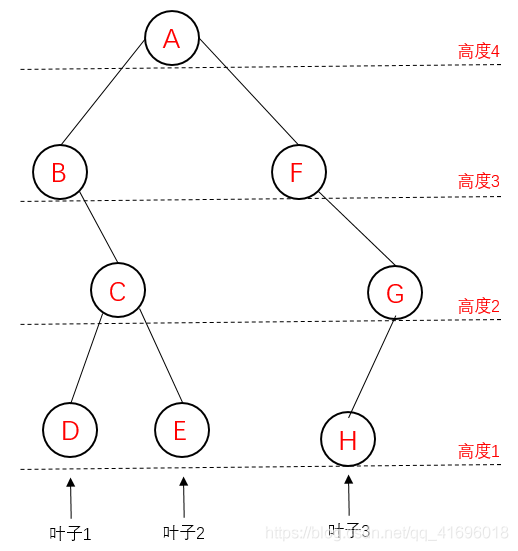-
C++数据结构X篇_15_求二叉树叶子数与高度(递归方法)
本篇参考求二叉树叶子数与高度(C++)进行整理。
1. 二叉树中叶子数与高度
我们首先来看一看二叉树中叶子数与高度的定义:
-
叶子数:对于一个二叉树的节点,若其既没有左子树又没有右子树,那它就是叶子节点。整个二叉树的叶子数为所有叶子节点个数。 -
高度:二叉树高度又称深度,其为根节点到叶子节点路径的最大值。

2. 求二叉树叶子数与高度的实现代码
求二叉树叶子数与高度均采用递归的方法,其基本操作方法都比较类似,具体实现代码如下:
#includeusing namespace std; //定义二叉树节点 class binarynode { public: char data; //节点数据域 binarynode* lchild; //左孩子 binarynode* rchild; //右孩子 }; //求树高度 int getheight(binarynode *root) { if (root == NULL) { return 0; } //求左子树高度 int lheight = getheight(root->lchild); //求右子树高度 int rheight = getheight(root->rchild); //当前节点高度 int height = lheight > rheight ? lheight + 1 : rheight + 1;; return height; } //求叶子节点,采用递归方法 void calculateleafnum(binarynode* root, int* leafnum) { if (root == NULL) { return; } if (root->rchild == NULL && root->lchild == NULL) { (*leafnum)++; } //左子树节点数目 calculateleafnum(root->lchild, leafnum); //右子树节点数目 calculateleafnum(root->rchild, leafnum); } //创建二叉树 void createtree() { //创建节点 binarynode node1 = { 'A',NULL,NULL }; binarynode node2 = { 'B',NULL,NULL }; binarynode node3 = { 'C',NULL,NULL }; binarynode node4 = { 'D',NULL,NULL }; binarynode node5 = { 'E',NULL,NULL }; binarynode node6 = { 'F',NULL,NULL }; binarynode node7 = { 'G',NULL,NULL }; binarynode node8 = { 'H',NULL,NULL }; //建立节点关系 node1.lchild = &node2; node1.rchild = &node6; node2.rchild = &node3; node3.lchild = &node4; node3.rchild = &node5; node6.rchild = &node7; node7.lchild = &node8; //计算二叉树高度 int height = getheight(&node1); cout << "二叉树的高度为:" << height << endl; //计算二叉树叶子数 int num = 0; calculateleafnum(&node1, &num); cout << "二叉树的节点为:" << num << endl; } int main() { createtree(); system("pause"); return 0; } - 1
- 2
- 3
- 4
- 5
- 6
- 7
- 8
- 9
- 10
- 11
- 12
- 13
- 14
- 15
- 16
- 17
- 18
- 19
- 20
- 21
- 22
- 23
- 24
- 25
- 26
- 27
- 28
- 29
- 30
- 31
- 32
- 33
- 34
- 35
- 36
- 37
- 38
- 39
- 40
- 41
- 42
- 43
- 44
- 45
- 46
- 47
- 48
- 49
- 50
- 51
- 52
- 53
- 54
- 55
- 56
- 57
- 58
- 59
- 60
- 61
- 62
- 63
- 64
- 65
- 66
- 67
- 68
- 69
- 70
- 71
- 72
- 73
- 74
- 75
- 76
- 77
运行结果:

-
-
相关阅读:
记一次 某智能制造MES系统CPU 爆高分析
IntelliJ IDEA 2023 最新版如何试用?IntelliJ IDEA 2023最新版试用方法及验证ja-netfilter配置成功提示
.Net Core 配置文件读取 - IOptions、IOptionsMonitor、IOptionsSnapshot
EDA工具开发中的调参方法
手部关键点检测1:手部关键点(手部姿势估计)数据集(含下载链接)
【建议背诵】软考高项考试案例简答题汇总~(6)
C. Building Permutation
win server 2012 r2 部署 netcore 站点 500.19
(pytorch进阶之路)DDPM回顾及Autoregressive diffuision model
【树上莫队C++】Count on Tree II(欧拉序降维,树链剖分求最近共同祖先LCA)
- 原文地址:https://blog.csdn.net/Dasis/article/details/133780237
